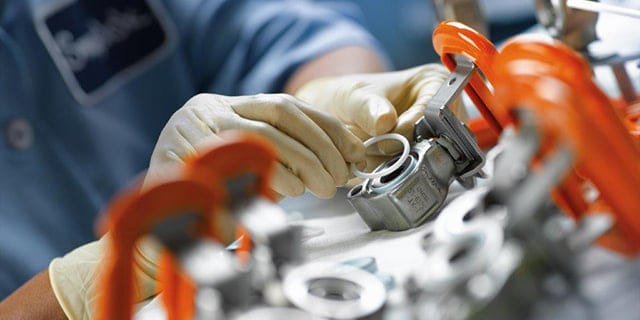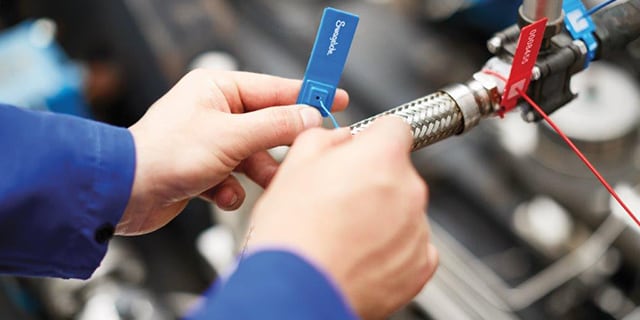A Guide to Industrial Valve Servicing and Maintenance

Best Practices for Fluid System Valve Servicing and Maintenance
Valves are some of the most important components of industrial fluid systems, responsible for controlling and maintaining optimal levels of flow. Their reliable functionality is critically important to operational efficiency, profitability, and safety—and that means fluid system operators need a plan for valve servicing and repair.
CTA Button: Learn Valve Basics So, what do you need to know about valve maintenance and valve servicing? Let’s look at some of the essentials of industrial valve maintenance.
Where Do Good Valve Maintenance Practices Begin?
Proper installation is the foundation of good valve maintenance practices. One common reason that a valve—or any fluid system component—may perform sub-optimally once in service is because it was installed improperly. A properly installed valve should help to reduce ongoing valve maintenance needs over the course of its life.
Follow these best practices to be confident in your valve installations:

✔ Always follow the manufacturer’s installation instructions. Read the instruction manual, attend training sessions, or watch videos in order to understand the proper steps of assembly and disassembly.
✔ Be aware of the capabilities and operating parameters of the system. For example, a valve should never be placed into service where the temperature or pressure inside the system exceeds the ratings of the valve.
✔ Allow adequate space for access and future maintenance. Maintaining a valve is typically a hands-on activity. Make sure you place valves in locations that are easily accessible, when possible.
✔ Mount valves securely to a fixed location whenever possible. Use adequate supports for the tubing or piping where possible on both sides of the valve to minimize vibration.
✔ Ensure the proper orientation of the valve to allow media to flow in the correct direction
✔ Check for leaks after installation
✔ Avoid contaminants. You can do this by adding filters to your fluid system to help remove particulates that may interfere with proper valve operation. Such particles can cause damage to valve seats, contaminate your process fluid, and reduce overall flow throughout your system.
Taking these things into consideration during the installation process can help best set up your valve for reliable operation over the long term.
How Do You Perform Preventative Valve Maintenance?
Developing a valve preventative maintenance (PM) schedule after installation helps ensure reliable operation. Tailor the schedule to your system’s needs, considering factors like pressure, temperature, process fluid, and valve usage. Consult your valve supplier for specific maintenance recommendations.
Regardless of your parameters, the goal of any valve maintenance program is to periodically verify that your valves are operating properly. The most common indicator of improper operation is a leak, be it minor or significant. Leaks can be detected with your own senses—you may smell a chemical leak before you can find it visually, for instance—or with ultrasonic equipment and liquid leak detectors. Catching a valve leak can help prevent a more serious problem that could occur if the leak were to continue undetected.
What is the First Step in Valve Maintenance? Safety.
Reference your company's safety procedures before performing any valve servicing or repair on individual valves. Certain worn or damaged components on a valve can be repaired or replaced; to identify which ones, always consult the manufacturer. When in doubt, replace the valve entirely to ensure safety.
Some common causes of leakage are unreliable metal-to-metal seals, contaminants in the system, improperly installed end connections, and poor tubing selection and preparation.
Valve Servicing and Troubleshooting Techniques
TEST - Verify its operation and determine the nature of the leak. There are two main forms of valve leakage:
- A seat leak, where the leak is contained inside the valve, but fluid passes through the seal and the valve is unable to stop the flow
- A shell leak, where fluid leaks outside of the valve into the atmosphere, often through the stem or body of the valve.
INSPECT - Examine all internal components, including the seats (a key part of ball valve maintenance), O-rings, and stem tips for wear or damage.
How Can You Minimize the Cost of Valve Leaks?
A good valve maintenance and servicing plan helps minimize the potential cost, safety, productivity, and environmental implications of leaks. Consider a hydraulic fitting leaking 6 drops of fluid per minute, where each drop is .05ml. That amounts to half a liter per day, or approximately 15 liters per month, or approximately 180 liters per year. Assuming the cost of hydraulic fluid is $15 USD per gallon (or approximately $4/liter) this leak costs you over $700 USD per year in lost fluid.
REPAIR - Worn components like seats, packing, and stems can often be replaced without the need to replace the valve entirely, based on the results of your inspection. In some instances, you may need to overhaul the valve, which involves replacing all internal wear components. Check with your valve supplier for available seal kits you can use to make repairs.
MAINTAIN - Adjust your PM schedules or procedures once you gain a better understanding of how valve wear occurs in any given application. You can use tags to offer technicians quick, easy visual indicators of what individual valves do and how often they may need to be inspected.
When Is Valve Replacement Recommended?
Significant damage or other factors to critical components may dictate valve replacement rather than valve servicing. Some examples include:
- Heavy corrosion may deteriorate the valve body, compromise its pressure-retaining capabilities and create a safety risk
- Major contamination that cannot be cleaned
- Overtightening a valve at its end connections can cause damage, rendering it unusable for reinstallation

There are other factors that may require replacement that have nothing to do with damage. You may determine that the cost of a new valve, combined with the labor and testing involved in repairing an existing one, is more advantageous. Potential production downtime is important to consider in any industrial valve maintenance activity.
***
Reliable valve operation is critical to the overall health and safety of your fluid systems. Being more familiar with the proper installation of valves, knowing the basics of valve servicing, and being able to properly implement an adequate valve maintenance program for your valves can all contribute to safer, more efficient, and more profitable operation.
Interested in learning more about valve maintenance? Swagelok offers valve training courses to help you deepen your knowledge on valves, their operation, and how to identify and solve common issues. Find out how these courses could benefit your operation.
Related Valve Servicing Articles

Why Relief Valves Are Essential for Chemical Plant Safety
Learn how to improve chemical plant safety and protect sensitive equipment by designing relief valves into critical applications to prevent potentially dangerous overpressurization.

How to Select Valves for Industrial Fluid Systems
Learn how to apply the practical STAMPED method to select the valves most suited to your industrial fluid or sampling system design applications.

How to Improve Your Maintenance Program with Valve and Hose Tags
Hear from two Swagelok specialists how a robust tagging system for hoses and valves throughout your industrial fluid systems can help you simplify maintenance and minimize system downtime.

